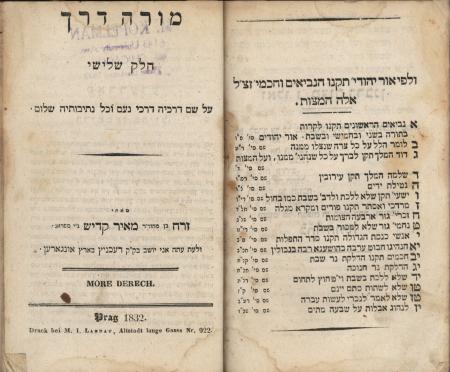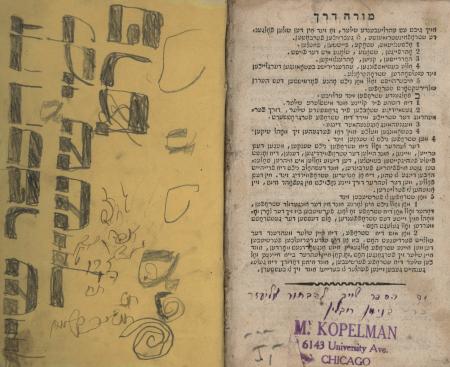Obj. ID: 39670
Jewish printed books Otzar ha-Chaim by Zerach ben Meir Kadish, Prague, 1832

© Gross Family Collection, Photographer: Unknown,
This text was prepared by William Gross:
Literacy has always been a primary goal for Jews throughout the Diaspora. Even during he dark ages the knowledge of reading and writing was maintained. The study of the Holy texts was impossible without these skills and such study was the goal of every Jewish male. Education began at an early age. There are many books and single sheets in the Gross Family Collection that are testimony to the efforts made for teaching.
One of the earlier books printed for children's Jewish education - it says that is is suitable for children from 3 years old to 13 - the volume also contains a lengthy explanation of the Mitzvot.
Summary and Remarks
Remarks
sub-set tree:
Name/Title
Otzar ha-Chaim by Zerach ben Meir Kadish | Unknown
Object Detail
Monument Setting
Unknown
Date
1832
Synagogue active dates
Reconstruction dates
Origin
Historical Origin
Unknown
Community type
Unknown |
Congregation
Unknown
Location
Unknown |
Site
Unknown
School/Style
Unknown|
Period
Unknown
Period Detail
Collection
Documentation / Research project
Unknown
Iconographical Subject
Unknown |
Textual Content
Unknown |
Languages of inscription
Unknown
Shape / Form
Unknown
Material / Technique
Paper, Ink, Letterpress
Material Stucture
Material Decoration
Material Bonding
Material Inscription
Material Additions
Material Cloth
Material Lining
Tesserae Arrangement
Density
Colors
Construction material
Measurements
Height
19 cm
Length
Width
12 cm
Depth
Circumference
Thickness
Diameter
Weight
Axis
Panel Measurements
Condition
Extant
Documented by CJA
Surveyed by CJA
Present Usage
Present Usage Details
Condition of Building Fabric
Architectural Significance type
Historical significance: Event/Period
Historical significance: Collective Memory/Folklore
Historical significance: Person
Architectural Significance: Style
Architectural Significance: Artistic Decoration
Urban significance
Significance Rating
0
Ornamentation
Custom
Contents
Codicology
Scribes
Script
Number of Lines
Ruling
Pricking
Quires
Catchwords
Hebrew Numeration
Blank Leaves
Direction/Location
Façade (main)
Endivances
Location of Torah Ark
Location of Apse
Location of Niche
Location of Reader's Desk
Location of Platform
Temp: Architecture Axis
Arrangement of Seats
Location of Women's Section
Direction Prayer
Direction Toward Jerusalem
Coin
Coin Series
Coin Ruler
Coin Year
Denomination
Signature
Colophon
Scribal Notes
Watermark
Hallmark
Group
Group
Group
Group
Group
Trade Mark
Binding
Decoration Program
Suggested Reconsdivuction
History/Provenance
Main Surveys & Excavations
Sources
Type
Documenter
|
Author of description
|
Architectural Drawings
|
Computer Reconstruction
|
Section Head
|
Language Editor
|
Donor
|
Object Copyright
Gross Family Collection (GFC)
Negative/Photo. No.
The following information on this monument will be completed:
Unknown |





